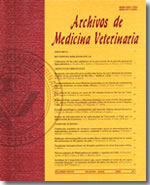Effects of magnesium supplementation as magnesium oxide in food or magnesium sulphate in water on the prevention of hypomagnesaemic tetany and blood and urine magnesium concentrations in hypomagnesaemic Hereford herds
Main Article Content
Abstract
The effects of supplementation with magnesium (Mg) salts on blood and urine Mg concentrations and the prevention of grass tetany in hypomagnesaemic beef herds were examined. Two systems of supplementation were tested in 4 beef herds at grazing, between July and December 1993. The herds had an average of 100 cows and were between 7 months pregnant and 2 months after calving. The herds presented clinical cases of grass tetany, dead animals and hypomagnesaemia diagnosed by metabolic profile test. In two herds the cows were supplemented with MgO, (50 g/d/cow, mixed with silage, hay or grounded oats) for 44 to 55 days. In one trial the cows were supplemented with MgSO4 (0.5% in the drinking water) for 44 days. In the last herd the cows were supplemented with MgSO4 before calving and with MgO after calving in a similar way to the previous trials.
Blood and urine samples were collected from 10 cows in each herd, starting 1 day before supplementation, and every 11±2 days during the supplementation period and for one week after. The concentrations of serum magnesium (Mg-s), urinary magnesium (Mg-u) and creatinine corrected urinary magnesium (CUM) were determined in the samples.
Of the two herds supplemented with MgO, only one presented a significant increase of Mg-s (p<0.05) during the supplementation period, reaching values of 0.71-0.78 mmol/l; whereas the Mg-u concentration of the same herd presented a significative increase (p<0.05), with values above the reference of <1.5 mmol/l. The herd supplemented with MgSO4 showed a significant increase of Mg-s (p<0.05) but the Mg-u did not increases during the supplementation period. In the last trial the Mg-s and Mg-u did not show any significant variation (p<0.05). The CUM presented a significant increase (p<0.05) in all the trials, but the values remained below the minimal reference value of 1 mmol/l. The proportion of animals with clinical hypomagnesaemic tetany decreased from 1.9% during the two months before supplementation to 0.3% and the mortality decreased from 1.2% to 0% in the same period.
According to these results, in beef cows with hypomagnesaemia, supplementation with MgO given in food or MgSO4 in the drinking water is effective in maintaining or increasing the concentrations of Mg-s, Mg-u and CUM, and in reducing the incidence of clinical cases and deaths produced by grass tetany.

